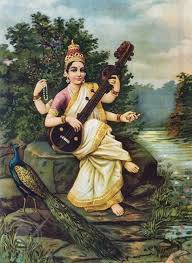There is different classification of Indian Paintings like Mural paintings, Miniature paintings etc. The word ‘miniature’ is derived from the Latin word ‘Minium’ which means red lead paint. The miniature painting art was developed in India between 8th and 12th centuries and further flourished with coming centuries.
Miniatures are small and detailed paintings and there are different schools which developed with time. The miniature paintings also developed in South Indian region with the emergence of different school. Other than that, the influence of European on paintings resulted in the emergence of modern style of paintings.
Also Read : Miniature Paintings – Techniques and Early Miniature
Miniature Paintings During Delhi Sultanate and Mughal Period
Miniature Art in South India
The art of paintings was prevalent in southern region of India from many ages. The miniature paintings were also part of early medieval period. They were differentiated from the paintings of north India in many ways, for example, the heavy use of gold in southern Indian miniature paintings was important feature unlike miniature paintings of North Indian states. They focused on painting divine creatures than the contemporary rulers. Tanjore and Mysore were the main centres of the miniature paintings in south.

Tanjore school used special style of decorative paintings. They were mostly created on glass or board instead of cloth and vellum. In 18th century, Maratha rulers patronised the Tanjore school art. They created larger than life images by using gemstones and glasses. It was the reign of Sarfoji Maharaj when these paintings reached to their zenith. This school is currently operative but moved towards the experiment with diverse subjects like animals, buildings, birds etc.
The Mysore school of painting was patronised by the rulers of Mysore and continued in British period as well. Hindu god and goddess were the main themes of these paintings. The important feature of these paintings is that they had two or three figures in every painting and one figure predominates the others. They used ‘gesso paste’ (mixture of zinc oxide and Arabic gum). They used muted colors that are not so bright.
Modern Paintings

The modern paintings are the mixture of many elements, for example, the Company paintings influenced the European elements and they promoted by British company as they employ painter to be trained in Indian styles. These painters mixed the European and Indian elements which gave rise to Company school. They used water colors and mainly originated in the regions of Kolkata, Chennai, Delhi, Patna etc.

Several painters were involved in painting the exotic flora and fauna of India and the most famous painters were Sewak Ram, Ishwari Prasad and Ghulam Ali Khan. The Bazaar school of paintings was influenced by European and did not take any influence from Indian school but form Roman and Greek statues. These paintings were prevalent in Bengal and Bihar regions. Raja Ravi Verma is one of India’s greatest painters, belonged to state of Kerala and was also dubbed as ‘Raphael of the East’. He painted lifelike paintings. Lady in the Moonlight, Mother India etc. his most famous paintings.
Thus, different style of paintings developed in India with the foreign influences as well.
